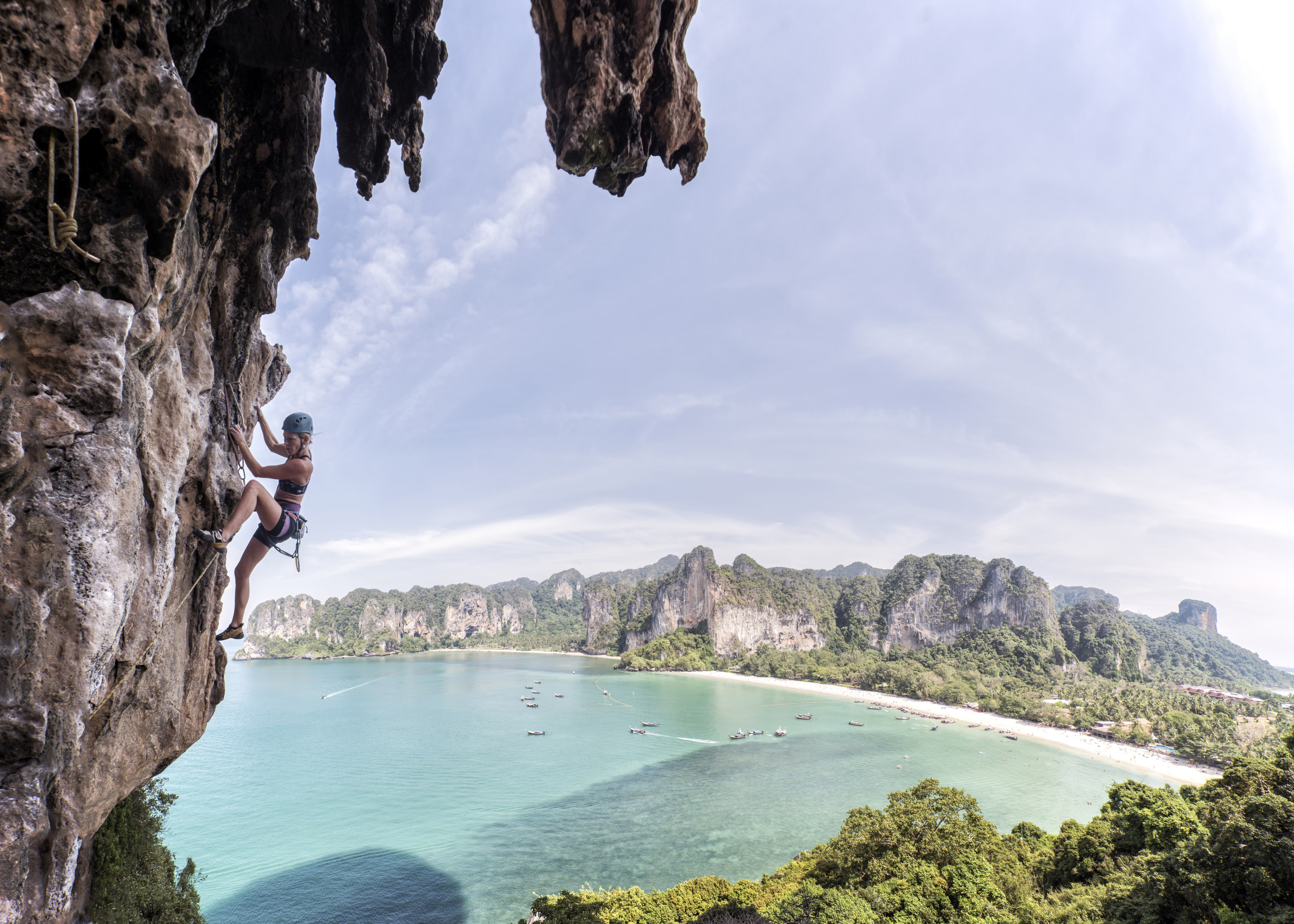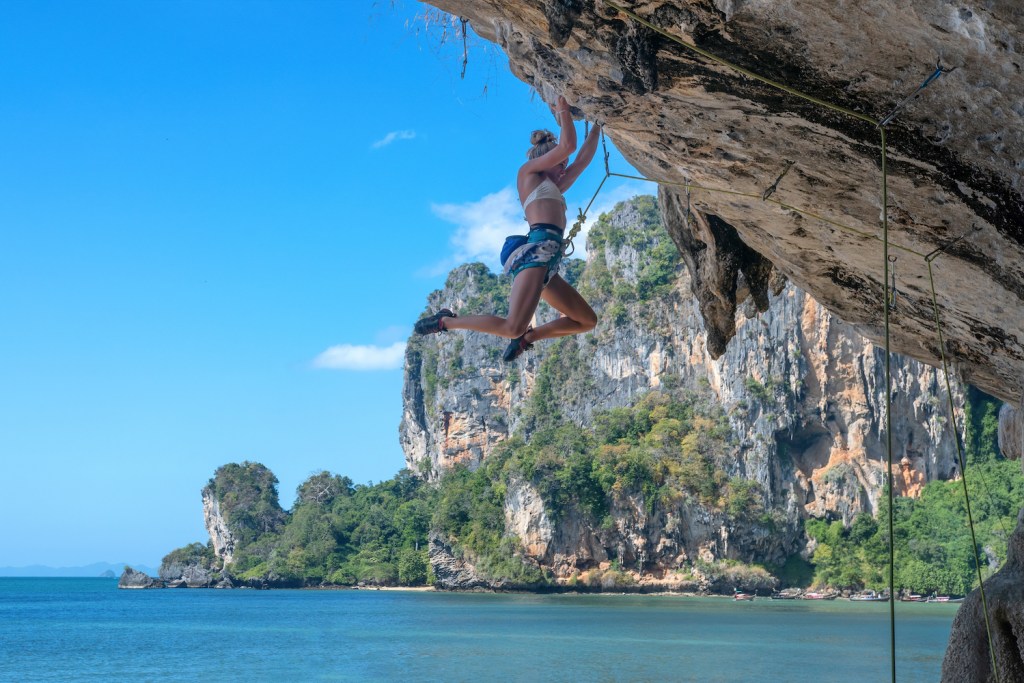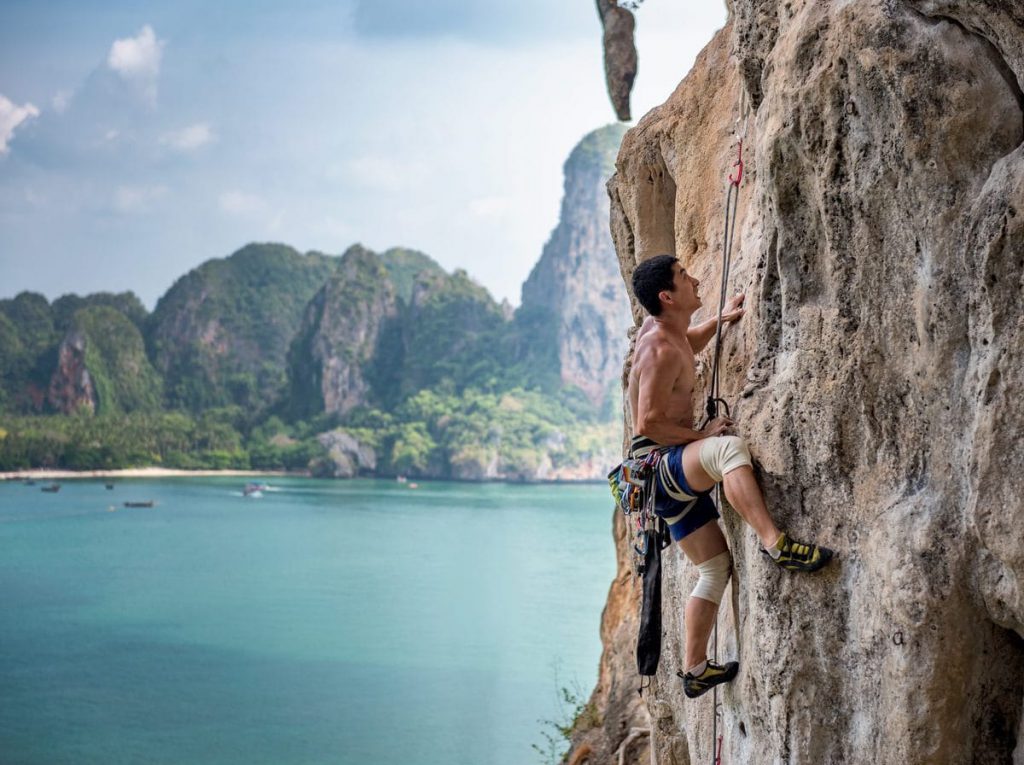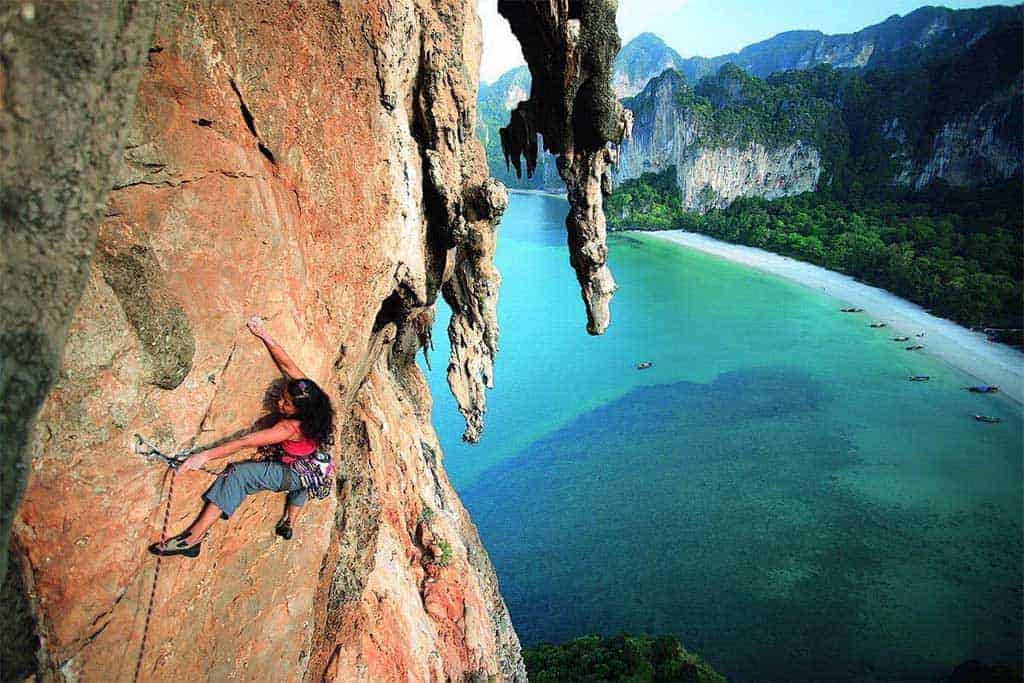Have you ever thought about trying rock climbing? It’s a thrilling and challenging activity that will test your strength and agility. And if you’re up for an adventure, why not give rock climbing in Thailand a try? With its towering limestone cliffs and breathtaking views, Thailand is a rock climber’s paradise. In this article, we’ll explore some of the top locations for rock climbing in Thailand and provide you with some tips to make the most out of your experience.
Thailand offers a wide range of rock climbing experiences for climbers of all levels. Whether you’re a beginner looking to try your hand at indoor climbing, or an experienced climber seeking the thrill of scaling towering cliffs, this country has something for everyone. In places like Railay Beach and Krabi, you’ll find stunning limestone cliffs that reach up into the sky, offering a variety of routes for climbers of different abilities.
If you’re new to rock climbing, it’s important to start with the basics. Thailand’s climbing schools and guided tours are a great way to get started, as they can provide you with the necessary equipment and expert instruction. And if you’re an experienced climber, there are plenty of challenging routes to conquer. Just remember to always prioritize safety and check the weather conditions before heading out.
In the following article, we’ll delve deeper into the top rock climbing locations in Thailand, such as Tonsai Beach and Chiang Mai, and provide you with more tips on equipment, techniques, and safety measures. So get ready to take your climbing skills to new heights and explore the stunning landscapes of Thailand while you’re at it. Stay tuned for more rock climbing inspiration!

Introduction
Rock Climbing in Thailand: An Adventurous Experience
If you’re an adrenaline junkie seeking a thrilling adventure, look no further than rock climbing in Thailand. With its stunning limestone cliffs, vibrant culture, and warm tropical weather, Thailand is the ideal destination for climbers of all experience levels. Whether you’re a beginner or a seasoned pro, the country offers a plethora of top-notch climbing locations that will leave you breathless. In this article, we will explore the top rock climbing locations in Thailand, discuss climbing grades and difficulty levels, provide essential gear and safety precautions, highlight the best time to go climbing, introduce climbing guides and instructors, offer tips on cultural etiquette and respect, suggest accommodation options, and explore the surrounding attractions. So put on your climbing shoes, tighten your harness, and let’s embark on a rock climbing adventure like no other in Thailand!
Why Thailand is the Ideal Destination for Rock Climbing
Thailand’s natural landscape is a rock climber’s paradise, offering an array of stunning limestone cliffs with endless vertical possibilities. The country’s diverse climbing locations cater to climbers of all skill levels, from beginners to seasoned experts. Moreover, Thailand’s tropical climate ensures pleasant weather throughout the year, making it possible to climb even during the winter months when other popular climbing destinations may be engulfed in snow or freezing temperatures. But it’s not just the exceptional climbing opportunities and favorable weather that make Thailand an ideal destination for climbers. The country’s unique blend of culture, warm hospitality, and delicious cuisine create an unforgettable experience both on and off the rocks. So pack your bags, get ready to explore the best rock climbing locations in Thailand, and embark on an adventure of a lifetime!
Top Rock Climbing Locations in Thailand
Railay Beach: A Climber’s Paradise
Tucked away on the Andaman Sea, Railay Beach is often referred to as a climber’s paradise. This breathtaking destination boasts towering limestone cliffs surrounded by crystal clear turquoise waters, creating a truly picturesque setting for climbers. Railay Beach offers a variety of routes suitable for climbers of all levels, from easy beginner-friendly climbs to challenging routes that will put even the most experienced climbers to the test. Popular climbing spots in Railay Beach include the iconic Phra Nang Cave, Fire Wall, and Tonsai Bay. The abundance of climbing schools and instructors in the area makes it an excellent choice for beginners who wish to learn the ropes and experience the thrill of rock climbing in a safe and supportive environment.
Koh Phi Phi: Experiencing Vertical Thrills
Another stunning destination for rock climbing in Thailand is the famous Koh Phi Phi. Known for its stunning natural beauty, including towering cliffs, crystal clear waters, and vibrant marine life, Koh Phi Phi offers a unique rock climbing experience like no other. Climbers can enjoy breathtaking views of Phi Phi Leh and Maya Bay as they ascend the cliffs, adding a touch of magic to their climbing adventures. The island offers a variety of routes, ranging from beginner-friendly walls to challenging multi-pitch climbs. Whether you’re a beginner or an experienced climber, Koh Phi Phi has something for everyone. The relaxed atmosphere, warm waters, and stunning scenery make this tropical paradise an irresistible destination for climbers looking for a unique and unforgettable climbing experience.
Chiang Mai: Scaling the Northern Peaks
If you’re seeking a different kind of rock climbing experience, head to Chiang Mai in northern Thailand. Known for its lush mountains and rich cultural heritage, Chiang Mai offers a truly unique climbing experience amidst stunning natural beauty. The cliffs in Chiang Mai are made of granite, providing a different type of rock to conquer. Climbers can enjoy challenging multi-pitch routes, as well as bouldering opportunities in the surrounding forests. The area is home to world-class climbing schools and experienced guides who can help you navigate the routes and ensure a safe and memorable climbing experience. Chiang Mai’s pleasant year-round weather and cultural charms make it an ideal destination for climbers seeking a combination of adventure and exploration.
Tonsai Beach: Bouldering Haven
For those who prefer bouldering, Tonsai Beach is a mecca for climbers seeking the thrill of scaling rocks without the use of ropes and harnesses. Located just a short boat ride away from Railay Beach, Tonsai Beach boasts a diverse range of bouldering problems suitable for climbers of all levels. The beach is nestled amidst lush greenery, providing climbers with a tranquil and secluded setting to test their skills. Whether you’re a bouldering enthusiast or a beginner looking to try something new, Tonsai Beach offers an unforgettable bouldering experience with its beautiful scenery and challenging routes.

Climbing Grades and Difficulty Levels
Understanding the Climbing Grade System
Before embarking on your rock climbing adventure in Thailand, it is important to understand the climbing grade system used to categorize the difficulty of routes. The most widely used grading system in Thailand is the French grading system, which consists of a series of numeric grades. The grades range from 1 to 9, with 1 being the easiest and 9 being the most challenging. Each numerical grade is further divided into three sub-grades, denoted by a, b, or c, with a being the easiest and c being the hardest within that numerical range. Additionally, the climbing grade may be followed by a plus or minus sign, indicating a slight increase or decrease in difficulty. It is advisable to start with routes that match your skill level to ensure a safe and enjoyable climbing experience.
Beginner-friendly Routes in Thailand
Thailand offers a plethora of beginner-friendly routes that provide the perfect introduction to rock climbing. Railay Beach, with its numerous climbing schools and supportive community, is an excellent choice for beginners. Climbers can start with easy routes on Phra Nang Beach or the popular Diamond Cave Wall. These routes offer manageable heights, good handholds, and a gentle learning curve, allowing beginners to gain confidence and progress at their own pace. Chiang Mai also offers several beginner-friendly routes, such as the Crazy Horse Buttress, which provides a fun and safe environment for newcomers to the sport.
Challenging Routes for Experienced Climbers
For seasoned climbers seeking a challenge, Thailand has an abundance of thrilling routes that will put your skills to the test. Railay Beach offers a range of challenging routes, including the infamous 123 Wall and the iconic Thaiwand Wall. These routes require advanced technical skills, endurance, and mental focus. Climbers looking for a more unconventional challenge can head to Chiang Mai and tackle the multi-pitch climbs on Doi Inthanon, the highest peak in Thailand. The exposure, difficult moves, and stunning views make these routes a favorite among experienced climbers.
Essential Gear and Safety Precautions
Must-Have Equipment for Rock Climbing in Thailand
Before you embark on your rock climbing adventure in Thailand, it is essential to have the right gear to ensure your safety and comfort. Here is a list of must-have equipment for rock climbing:
- Climbing harness: A properly fitted climbing harness is essential for safety and comfort during your climbs.
- Climbing shoes: Invest in a pair of climbing shoes that provide a good fit and grip on the rock.
- Helmet: Protect your head from falling debris or accidental impacts by wearing a climbing helmet.
- Belay device: A belay device is used to control the rope during a climb and is a vital tool for both the climber and the belayer.
- Carabiners: Strong and reliable carabiners are necessary for attaching ropes and other equipment to your harness.
- Climbing rope: Choose a dynamic climbing rope that can handle the stress of a fall and is long enough for the routes you plan to climb.
- Quickdraws: Quickdraws are used to attach the climbing rope to bolts or protection points on the route.
- Chalk bag: A chalk bag helps keep your hands dry and improve your grip on the rock.
- Slings and webbing: Slings and webbing are essential for building anchors and extending protection points.
It is important to regularly inspect and maintain your gear to ensure its safety and effectiveness. If you are unsure about any aspect of your gear or its usage, seek guidance from a professional guide or instructor.
Safety Tips to Ensure a Smooth Climbing Experience
Rock climbing can be a physically demanding and potentially dangerous activity. To ensure a safe and enjoyable climbing experience, follow these safety tips:
- Seek professional instruction: If you are new to rock climbing, it is highly recommended to take a course or hire a certified instructor to learn proper climbing techniques and safety protocols.
- Warm-up and cool-down: Stretch and warm-up your muscles before each climb to prevent injuries. After climbing, cool down and stretch to help your muscles recover.
- Use proper climbing techniques: Learn and practice proper climbing techniques such as footwork, hand placement, and body positioning to improve your efficiency and reduce the risk of injury.
- Communicate effectively: Maintain clear and concise communication with your climbing partner or belayer to ensure a smooth and safe climbing experience.
- Check your gear: Regularly inspect your gear and ropes for signs of wear and tear. Replace any damaged or worn-out equipment immediately.
- Stay hydrated and fueled: Drink plenty of water and eat nutritious snacks to maintain your energy levels and prevent dehydration during climbs.
- Respect environmental cues: Pay attention to weather conditions, rock stability, and route conditions. Do not attempt climbs during adverse weather or if the rock is wet or unstable.
- Respect your limits: Know your physical and mental limits and do not push yourself beyond what you are comfortable with. Listen to your body and take breaks when needed.
By following these safety tips and using proper climbing techniques and equipment, you can minimize the risks associated with rock climbing and ensure a smooth and enjoyable climbing experience in Thailand.

Best Time to Go Rock Climbing
Climbing Seasons in Thailand
Thailand’s tropical climate offers favorable conditions for rock climbing throughout the year, but there are certain seasons that are considered ideal for climbing. The two main climbing seasons in Thailand are the dry season and the cool season. The dry season, which runs from November to April, is the most popular time for rock climbing as the weather is dry and relatively cool. During this time, climbers can enjoy stable conditions, clear skies, and comfortable temperatures. The cool season, from November to February, offers pleasant weather and cooler temperatures, making it an ideal time for climbing activities.
It is important to note that Thailand’s climate can vary depending on the region. While some areas may experience heavy rainfall during the wet season, others may remain relatively dry. It is advisable to check the local weather conditions and consult with climbing guides or instructors for the most up-to-date information before planning your climbing trip.
Ideal Weather Conditions for Climbing
The ideal weather conditions for rock climbing in Thailand include clear skies, low humidity, and moderate temperatures. Climbing in hot and humid conditions can be physically demanding and potentially dangerous, as it can lead to dehydration and increased fatigue. It is advisable to climb during the early morning or late afternoon when temperatures are lower and the sun is not as intense. Additionally, climbers should be mindful of the sun’s UV rays and protect themselves by wearing sunscreen, sunglasses, and a hat.
Thailand’s tropical climate can be unpredictable at times, with sudden showers or thunderstorms occurring even during the dry season. It is important to be prepared for changing weather conditions and have a backup plan in case climbing needs to be postponed or rescheduled. Always prioritize your safety and the safety of those around you when making decisions about climbing in uncertain weather conditions.
Climbing Guides and Instructors
Professional Guides and Instructors: Enhancing Your Climbing Experience
To make the most of your rock climbing adventure in Thailand, consider hiring a professional guide or instructor. Professional guides and instructors have extensive knowledge about the local climbing areas, route conditions, safety protocols, and first aid techniques. They can provide valuable guidance, support, and instruction tailored to your skill level and climbing goals. Hiring a professional guide or instructor can help enhance your climbing experience, boost your confidence, and ensure a safe and enjoyable adventure.
Choosing the Right Guide for Your Skill Level
When choosing a guide or instructor, it is important to consider their experience, certifications, and familiarity with the climbing areas you wish to explore. Look for guides who are certified by reputable climbing organizations such as the American Mountain Guides Association (AMGA) or the International Federation of Mountain Guides Associations (IFMGA). These certifications ensure that the guide has undergone rigorous training and adheres to high safety standards.
Additionally, consider the guide’s experience working with climbers of your skill level. Some guides specialize in working with beginners, while others may have more expertise in guiding experienced climbers on challenging routes. By selecting a guide who aligns with your skill level and goals, you can maximize your learning experience and feel confident in their abilities to lead you safely on your climbing adventures.

Cultural Etiquette and Respect
Respecting Local Customs and Traditions
When visiting Thailand for rock climbing, it is important to respect the local customs and traditions. Thai culture places great importance on respect, politeness, and maintaining harmony. Here are a few cultural etiquettes to keep in mind:
- Dress modestly: When in public spaces or visiting religious sites, dress modestly by covering your shoulders and knees to show respect.
- Remove your shoes: Take off your shoes before entering temples, homes, and some restaurants, as it is considered impolite to wear shoes indoors.
- Practice wai: The Thai greeting known as wai is done by placing your palms together in a prayer-like gesture and bowing slightly. Use the wai to greet locals and show respect.
- Be mindful of Buddhist traditions: If you encounter Buddhist monks or visit Buddhist temples, be respectful of their traditions by not touching or pointing at statues, refraining from loud conversations or laughter, and dressing appropriately.
- Follow local customs: Observe and follow local customs and practices, such as queuing in an orderly manner and addressing locals with respect.
By being aware of and respectful towards Thai customs and traditions, you can foster positive interactions with locals and contribute to a harmonious and enjoyable climbing experience in Thailand.
Sustainable Practices for Rock Climbing in Thailand
An essential aspect of responsible climbing is practicing sustainable techniques to minimize the impact on the environment and local communities. Here are a few sustainable practices to consider during your rock climbing adventures in Thailand:
- Leave no trace: Pack out all your trash and dispose of it properly. Avoid leaving any waste or litter behind, and pick up any trash you may find on your climbs to keep the climbing areas clean and pristine.
- Stay on designated paths: Stick to established trails and paths to avoid trampling on vegetation and causing erosion.
- Respect wildlife: Do not disturb or feed wildlife, and observe animals from a safe distance to protect their natural habitat and behavior.
- Support local communities: Contribute to the local economy by staying in locally-owned accommodation, eating at local restaurants, and purchasing sustainable and locally-made climbing gear or souvenirs.
- Stay informed: Stay up to date with local regulations and guidelines related to climbing and adhere to them. Respect any temporary closures or restrictions in place to protect the environment or cultural sites.
By practicing sustainable climbing techniques, you can help preserve the natural beauty of Thailand’s climbing areas and ensure that future generations can continue to enjoy these magnificent locations.
Where to Stay: Accommodation Options
Budget-Friendly Accommodations for Climbers
Thailand offers a wide range of accommodation options to suit every budget. For budget-conscious climbers, there are plenty of guesthouses, hostels, and bungalows available near popular climbing areas. Railay Beach, Tonsai Beach, and Koh Phi Phi are known for their affordable accommodations, with numerous beachfront bungalows and guesthouses within walking distance of the climbing spots. These budget-friendly accommodations provide basic amenities, comfortable beds, and often have communal areas where climbers can socialize and swap climbing stories with fellow adventurers.
Luxurious Resorts and Villas with Climbing Facilities
If you prefer a more luxurious experience, Thailand also offers a variety of upscale resorts and villas that cater to climbers. Many of these accommodations are located near the top climbing areas and offer breathtaking views, luxurious amenities, and climbing facilities to cater to the needs of climbers. These resorts often have their own climbing walls or offer guided climbing excursions for guests. Staying in a luxurious resort or villa can provide a pampering escape after a day of climbing, allowing you to relax and rejuvenate in style.
When choosing your accommodation, consider factors such as proximity to climbing areas, amenities, price, and the overall ambiance that suits your preferences and needs.

Exploring the Surrounding Attractions
Beyond Climbing: Tourist Attractions Near Rock Climbing Locations
While rock climbing may be the main draw for many travelers visiting Thailand, the country offers a wealth of other attractions that are well worth exploring. Take a break from climbing and immerse yourself in the rich cultural heritage, vibrant markets, and stunning natural beauty that Thailand has to offer. Here are a few nearby attractions you can explore:
- Beaches and islands: Thailand is renowned for its beautiful beaches and idyllic islands. Take a break from climbing to relax and unwind on picturesque beaches such as Maya Bay, Phra Nang Beach, or Long Beach. Take a boat tour to explore the nearby islands and discover hidden gems.
- Temples and historical sites: Thailand is home to countless temples and historical sites that showcase its rich history and spiritual heritage. Visit the iconic Wat Arun in Bangkok, explore the ancient city of Ayutthaya, or experience the serenity of the White Temple in Chiang Rai.
- Thai cuisine: Indulge your taste buds in Thailand’s world-famous cuisine. Sample the vibrant flavors of traditional Thai dishes such as Pad Thai, Tom Yum soup, and green curry. Try street food delicacies at local markets or embark on a culinary tour to learn the secrets of Thai cooking.
- National parks and nature reserves: Explore Thailand’s diverse ecosystems by visiting national parks and nature reserves. Hike through tropical rainforests, spot wildlife, and marvel at majestic waterfalls. Khao Sok National Park, Doi Inthanon National Park, and Erawan National Park are just a few examples of the natural wonders that await.
- Cultural experiences: Immerse yourself in Thai culture by attending traditional dance performances, participating in a Thai cooking class, or visiting local villages to learn about traditional crafts and customs.
Thailand offers a myriad of attractions and experiences that perfectly complement your rock climbing adventures, providing a well-rounded and memorable journey.
Conclusion
Realize Your Rock Climbing Dreams in Thailand
Thailand’s stunning limestone cliffs, favorable weather, and vibrant culture make it an unparalleled destination for rock climbers from around the world. Whether you’re a beginner or an experienced climber, Thailand offers an array of top-notch climbing locations that cater to all skill levels. From the breathtaking Railay Beach with its iconic climbing routes to the enchanting Koh Phi Phi and its vertical thrills, the country provides a plethora of opportunities for unforgettable climbing experiences. Remember to follow the climbing grades and choose routes suitable for your skill level, wear appropriate gear, and prioritize safety at all times. Respect the local customs, practice sustainable climbing techniques, and immerse yourself in the rich culture and natural beauty that Thailand has to offer. With its warm hospitality, stunning scenery, and endless vertical possibilities, Thailand is sure to fulfill your rock climbing dreams and create memories that will last a lifetime. So pack your bags, challenge your limits, and embark on an adventure of a lifetime in the land of smiles!
